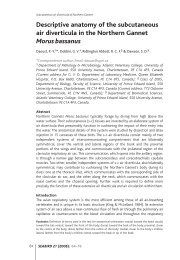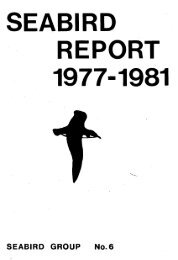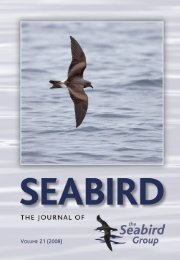You also want an ePaper? Increase the reach of your titles
YUMPU automatically turns print PDFs into web optimized ePapers that Google loves.
2001 Body mass reduction in Kittiwakes 167<br />
MATERIALS & METHODS<br />
<strong>The</strong> study was performed in a Black-legged Kittiwake colony at Kongsfjorden<br />
(78°54'N 12°13'E), 7 km west of Ny-Ålesund on Svalbard. In this colony about<br />
600 Black-legged Kittiwake pairs breed with 50-100 Brünnich’s Guillemots<br />
Uria lomvia and five to ten pairs of Black Guillemots Cepphus grylle (Mehlum<br />
& Fjeld 1987). <strong>The</strong> birds experience continuous daylight throughout the<br />
breeding season.<br />
In two breeding seasons, 11 June-13 August 1997 and 19 June-29 July<br />
1998, the colony was visited on a regular basis in order to record nest contents<br />
and hatching dates. Females used in the experiments were randomly selected<br />
after their sex, based on biometric measurements, had been confirmed. <strong>The</strong>y<br />
were all breeding but no consideration was taken of their clutch or brood size<br />
(mainly because of an insufficient number of single egg/chick nests). <strong>The</strong> adult<br />
birds were captured when sitting on their nests, using a fishing pole fitted with a<br />
terminal noose. On the first capture, measurements of head+bill (skull) length<br />
were obtained to the nearest 0.1 mm, using a flexible ruler. Body masses were<br />
obtained to the nearest 1.0 g on every capture occasion, using a spring balance.<br />
For pairs for which data from both adults were obtained, the sexes were<br />
differentiated according to their relative size, the smaller (in both body mass and<br />
size) being the female. This method gave 98% correct determination when<br />
sexing Black-legged Kittiwakes on Hornøya, 70°N (Pichl 1997). When only one<br />
individual in a pair was captured, the females were assumed to have a skull<br />
length of less than 92.1 mm, and males were assumed to have a skull length of<br />
more than 92.1 mm. This method gave 87% correct determination when sexing<br />
Black-legged Kittiwakes on Hornøya (Barrett et al. 1985). We managed to<br />
capture the partner of all but one of the experimental birds. This female had a<br />
skull length of 91.4 mm, which is well beyond (0.7 mm) the limit of 92.1 mm,<br />
and we are therefore trusting that all the experimental birds were females.<br />
Altogether we obtained 67 measurements of BMR in 40 female Blacklegged<br />
Kittiwakes, of which 24 measurements were made during the incubation<br />
period (in 1997), 10 just around hatching time (in 1998), 17 about two weeks<br />
after hatching (in 1997) and 16 late during the chick-rearing period (7 in 1997<br />
and 9 in 1998). Metabolic rates were measured indirectly as the rates of oxygen<br />
consumption in resting post-absorptive individuals, using open flow-through<br />
respirometry. After capture in the field, the Black-legged Kittiwakes were<br />
placed in a cage and transported to a laboratory in Ny-Ålesund for BMRmeasurements.<br />
Within 7 hours (on average) the Black-legged Kittiwakes were<br />
placed in a metabolic chamber of approximately 25 l, in which the ambient<br />
temperature (Ta) was measured using a copper-constantan thermocouple<br />
(California Fine W ire Co., type 0.005). Dry outside air was drawn through the








